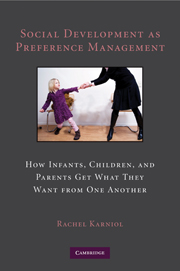 Social Development as Preference Management
Social Development as Preference Management Book contents
- Frontmatter
- Contents
- Acknowledgments
- Introduction
- 1 The Baby “Preference Game”
- 2 Children's Expression of Preferences
- 3 Emerging Meta-Preferences
- 4 Other People's Preferences
- 5 Parenting and Preference Management
- 6 Channeling Children's Preferences
- 7 Temporizing Preferences
- 8 Restricting Children's Preferences
- 9 Disciplining Noncompliance
- 10 Planes of Transformational Thought: Temporal, Imaginal, and Mental
- 11 Manipulating Others
- 12 Coping and Self-Regulating
- 13 Mind Play: Applying Transformational Thought
- 14 Minding One's Own Versus Others' Preferences: Altruism, Aggression, and Morality
- 15 Tying Up
- References
- Subject Index
- Name Index
8 - Restricting Children's Preferences
Published online by Cambridge University Press: 05 June 2012
- Frontmatter
- Contents
- Acknowledgments
- Introduction
- 1 The Baby “Preference Game”
- 2 Children's Expression of Preferences
- 3 Emerging Meta-Preferences
- 4 Other People's Preferences
- 5 Parenting and Preference Management
- 6 Channeling Children's Preferences
- 7 Temporizing Preferences
- 8 Restricting Children's Preferences
- 9 Disciplining Noncompliance
- 10 Planes of Transformational Thought: Temporal, Imaginal, and Mental
- 11 Manipulating Others
- 12 Coping and Self-Regulating
- 13 Mind Play: Applying Transformational Thought
- 14 Minding One's Own Versus Others' Preferences: Altruism, Aggression, and Morality
- 15 Tying Up
- References
- Subject Index
- Name Index
Summary
A 10-month-old shakes a clock. Her mother takes it from her, saying, ‘No let's put it back.’ When the child starts crying, her mother asks, ‘What's the matter? What's the matter? What do you want? What is it that you want? Is it this?’
(reprinted from Lock, 1980, p. 54)A child of 3 shows his mother a ladybird and she see his hands are dirty. She says, ‘Just look at your hands…. Go wash your hands now.’ When he ignores her, she says, ‘Go wash your hands now – do as I say.’ When he still ignores her, she says, ‘Go wash you hands and don't make a mess'; he goes to wash his hands.
(Hall, CHILDES Database)Parents’ external preferences also relate to what their children should not do. Parents attempt to manage children's preferences by restricting, or attempting to restrict, behavior deemed undesirable, and they discipline children when restricted behavior is engaged in against their wishes. In this chapter, I trace how parents express restrictions to their children and the strategies they adopt in attempting to enforce compliance with their expressed restrictions. In Chapter 9, I focus on strategies of disciplining children who have failed to comply with restrictions.
THE PREVALENCE OF RULES
Children's world is full of restrictions and guidelines for interacting with objects and people. Rules, whether explicit or implicit, set limitations on behavior and set up expectations for how others will react to rule-following and rule-breaking behavior. We seldom realize the myriad of rules that guide children's behavior.
- Type
- Chapter
- Information
- Social Development as Preference ManagementHow Infants, Children, and Parents Get What They Want from One Another, pp. 149 - 170Publisher: Cambridge University PressPrint publication year: 2010


